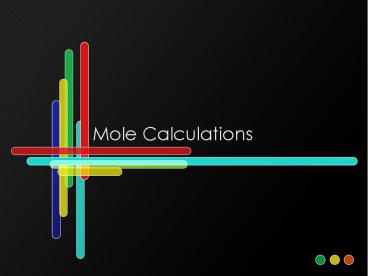Mole Calculations - PowerPoint PPT Presentation
Title:
Mole Calculations
Description:
Mass of 1 mole of compound. Found by adding the atomic weights of each atom of each ... Change 0.45 moles of barium chlorate to grams of barium chlorate. ... – PowerPoint PPT presentation
Number of Views:582
Avg rating:3.0/5.0
Title: Mole Calculations
1
Mole Calculations
2
The Mole
- Mole measurement of the amount of a substance.
- We know the amount of different substances in one
mole of that substance.
3
Atomic Mass Unit
- Mass of 1 mole of compound
- Found by adding the atomic weights of each atom
of each element that makes up a compound. - H2O
- There are 2 atoms of hydrogen and 1 atom of
oxygen.
4
AMU
- H 2 x 1.01 2.02
- O 1 x 16 16
- _____
- 18.02 amu
- 1 mole of any substance the amu of that
substance
5
AMU
- Molar mass the sum of the molar masses of atoms
of the elements in the formula - Calculated the same way
6
The Mole
- One mole of any substance has Avogadros number.
- 6.022 x 1023 atoms, molecules, ions
7
The Mole
- For gases only 1 mole of a gas occupies 22.4 L
8
Converting Between Units
- amu ? 1 mole ? 6.022 x 1023 atoms, mlc, ions
- (expressed
- in grams)
9
Conversions
- Change 5.0 grams of sodium chloride to moles of
sodium chloride.
10
- Change 0.45 moles of barium chlorate to grams of
barium chlorate.
11
- Determine the number of atoms in 15 grams of
water.
12
Empirical Formulas
13
Empirical Formulas
- The simplest whole number ratio of moles of each
element in the compound. - H2O
- NaCl
14
Empirical Formulas
- Usually given in percentages of each element in
the compound. - Based on 100 of the compound.
- Can be compared to a 100 gram sample of the
substance. - 11.2 Hydrogen
- 88.8 Oxygen
15
- 1. Change percents to grams
- 11.2 H 11.2 g H
- 88.8 O 88.8 g O
16
- 2. Convert grams to moles. (We know an
empirical formula is the lowest whole number
ratio of moles) - 11.2 g H 1 mol 11.089 mol
- 1.01 g
- 88.8g O 1 mol 5.550 mol
- 16 g
17
- Cannot have decimals, the numbers must be whole
numbers. Divide by the lowest. - 11.2 g H 1 mol 11.089 mol / 5.550 2
- 1.01 g
- 88.8g O 1 mol 5.550 mol / 5.550 1
- 16 g
- H2O empirical formula
18
- 36.84 N
- 63.16 O
19
- 35.98 Al
- 64.02 S
20
Molecular Formula
21
- Specifies the actual number of atoms of each
element in one molecule or formula unit of the
substance.
22
- The molar mass of acetylene is 26.04 g/mol and
the mass of the empirical formula, CH, is 13.02
g/mol
23
- 1. The problem will give you a molar mass of the
compound. - 2. Calculate the empirical formula as usual.
24
- 40.68 carbon
- 5.08 hydrogen
- 54.24 oxygen
- Molar mass 118.1 g/mol
25
- Change to grams
- 40.68 g C 1 mol 3.387 mol
- 12.01 g
- 5.08 g H 1 mol 5.030 mol
- 1.01 g
- 54.24 g O 1 mol 3.390 mol
- 16 g
26
- 3.387 mol / 3.387 mol 1 x2 2
- 5.030 mol / 3.387 mol 1.5 x2 3
- 3.390 mol / 3.387 mol 1 x2 2
- Empirical Formula C2H3O2
27
- To find the molecular formula
- (EFamu)x MM (molar mass)
28
- C2H3O2 59.05 amu
- (59.05)x 118.1
- X 2
- (EF)x2 (C2H3O2)x2 C4H6O4
29
- 65.45 C
- 5.45 H
- 29.09 O
- MM 110.0 g/mol
30
- 49.98 g C
- 10.47 g H
- MM 58.12 g/mol
31
- 46.68 N
- 53.32 O
- MM 60.01 g/mol































